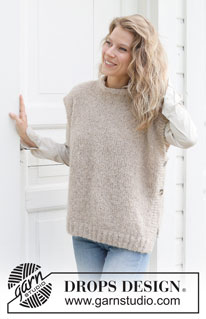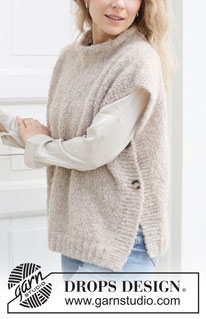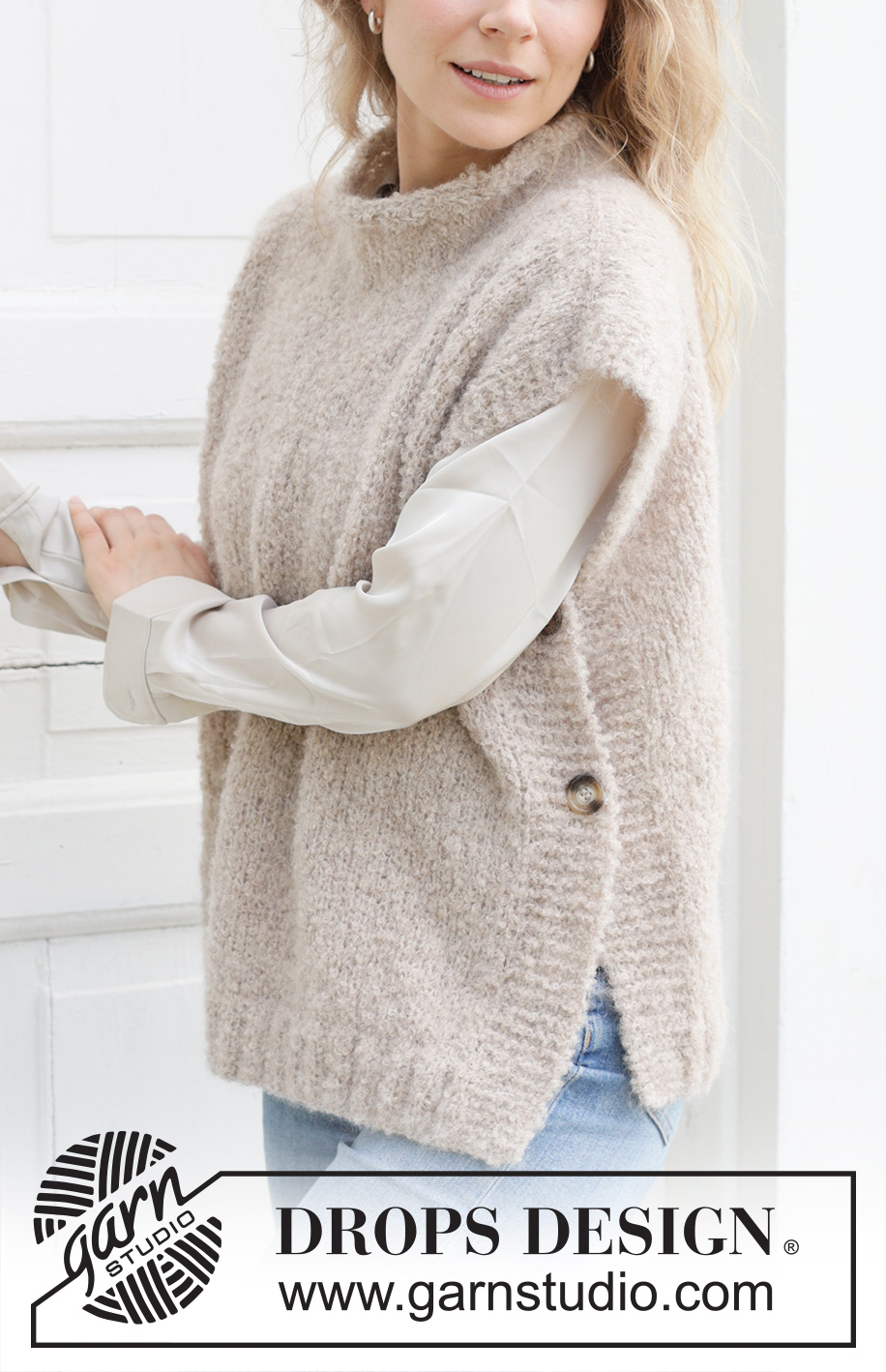Comments / Questions (35)
![]() Hélène wrote:
Hélène wrote:
Comment faire pour avoir les explications pour les aiguilles non circulaires ?
11.07.2025 - 18:03DROPS Design answered:
Bonjour Hélène, ce pull est tricoté en allers et retours sur aiguille circulaire, donc vous pouvez le faire sur les aiguilles droites sans aucun probleme. Seul le col est tricoté en rond, vous pouvez utiliser aiguille circulaire ou double pointes. Bon tricot!
14.07.2025 - 08:40
![]() Birgitta Alm wrote:
Birgitta Alm wrote:
Behov av storlekbestämmning med hjälp av mått kring bröstet angivet i centimeter
26.06.2025 - 13:31DROPS Design answered:
Hej Birgitta, du finder måleskitsen nederst i opskriften. Den mindste størrelse måler 56cm x 2 = 112 cm i omkreds :)
26.06.2025 - 14:05
![]() Rae Pang wrote:
Rae Pang wrote:
Hello, l am confused as to how many balls of wool do l need for a Size 18-20. Love this vest, looks great for our approaching winter
26.04.2025 - 01:14DROPS Design answered:
Dear Rae, since sizes vary between countries, our sizes are established as S-XXXL, and the measurements for each size in each pattern are indicated in the size schematic at the end of the pattern, in cm. You can also find some of the measurements at the top of the pattern in inches in the US version of the pattern. We recommend you read this lesson and check one of your favourite garment's measurements and compare them to the measurements in the size chart to choose your size. Happy knitting!
27.04.2025 - 11:58
![]() ZOI TSIGARIDA wrote:
ZOI TSIGARIDA wrote:
Good evening, I have just started knitting and I don't know much about yarns. You say that DROPS Alpaca Bouclé is feltable. This happens only when it is machine washed ? Does felting happen when it's hand washed? If I use DROPS Big Merino instead, could I machine wash it or felting will happen because of the DROPS Kid-Silk(hand wash recommended) ? Thank you in advance
10.03.2025 - 19:06DROPS Design answered:
Hi Zoi, Yarns which are suitable for felting will only felt when washed in the washing machine at 40 degrees. A gentle hand wash at a lower temperature will not felt these yarns. If you have Drops Kid-Silk in the wool-mix, you will need to handwash the garment to maintain the size and shape. Happy crafting!
11.03.2025 - 06:34
![]() AVIS wrote:
AVIS wrote:
Pourquoi 2 grandeurs d’aiguilles circulaires no 6 et si oui, à quel moment du tricot faut-il en CHANGER ???
07.03.2025 - 16:46DROPS Design answered:
Bonjour Mme Avis, on utilise l'aiguille circulaire de 80 cm pour tricoter le devant et le dos, et on utilise l'aiguille circulaire de 40 cm pour tricoter le col. Bon tricot!
10.03.2025 - 07:50
![]() Ann-Cathrin Bäckgren wrote:
Ann-Cathrin Bäckgren wrote:
Vilket garn kan jag använda istället för det garner som står i mönstret
05.03.2025 - 16:46DROPS Design answered:
Hej Ann-Cathrin. Du kan använda andra garn i samma garngrupp, dvs garngrupp C respektive A. Tänk bara på att få den stickfasthet som uppges i mönstret och att beräkna riktig garnåtgång (använd gärna vår garn konverterare). Mvh DROPS Design
06.03.2025 - 09:36
![]() Anne Andersen wrote:
Anne Andersen wrote:
Jeg er kommet dertil hvor der skal lukkes 4 masker af til ærmegab i hver side af retstrikken. Er det de første 4 masker eller de sidste 4 masker af retstrikken der lukkes af?
23.02.2025 - 11:58DROPS Design answered:
Hei Anne. Når bagstykke måler 36-37-38-39-40-41 cm lukkes der 4 masker AF I HVER SIDE til ærmegab = 70-76-82-88-98-106 masker. Fortsæt med glatstrik og 4 masker retstrik i HVER SIDE. mvh DROPS Design
03.03.2025 - 10:05
![]() Stieneke Van Es wrote:
Stieneke Van Es wrote:
Is er met dit garen ook te haken
11.02.2025 - 22:53DROPS Design answered:
Dag Stieneke,
Ja hoor, je kunt ook haken met dit garen. Omdat het boucle garen is zullen de steken minder opvallen en het haakt natuurlijk iets lastiger dan meer glad garen, omdat je allemaal lusjes hebt.
12.02.2025 - 13:54
![]() Mette Winther wrote:
Mette Winther wrote:
Jeg er begyndt på vesten, og glæder mig til den er færdig, men jeg synes der er noget ubalance i retstrikskanten. Jeg starter ud med at strikke på p. 4.5, men da jeg skal til glatstrik bliver kanten jo også strikket på pind 6. Det gør at den nederste kant trækker ind, hvilket jeg ikke synes er pænt. Er det en fejl eller skal det være sådan ?
10.02.2025 - 12:58
![]() Christine Schmitt wrote:
Christine Schmitt wrote:
Modele
08.02.2025 - 19:28
Latte Love Vest#lattelovevest |
|
 |
 |
Knitted waistcoat in DROPS Alpaca Bouclé and DROPS Kid-Silk. Piece is knitted bottom up in stocking stitch with edges in garter stitch, i-cord and opening in the side. Size: S - XXXL
DROPS 255-40 |
|
|
---------------------------------------------------------- EXPLANATION FOR THE PATTERN: ---------------------------------------------------------- GARTER STITCH (when working back and forth): Knit on all rows, i.e. knit from right side and knit from wrong side. 1 ridge vertically = knit 2 rows. I-CORD CAST-OFF: At the end of round and after last stitch on round has been worked: Cast on 3 new stitches on right needle from right side. Slip the 3 new stitches from right needle to left needle so that working yarn is 3 stitches in on left needle (the working yarn tightens the piece when working to form a little tube). ROW 1 (= right side): Knit 2, knit the next 2 stitches twisted together. ROW 2 (= right side): Slip the 3 stitches from right needle back on left needle, knit 2, knit the next 2 stitches twisted together. AFTER 2ND ROW: Repeat ROW 2 until 3 stitches remain on right needle. Slip the 3 stitches from right needle back on left needle. Cast off. Sew a little stitch that binds beginning/end of I-cord together. ---------------------------------------------------------- START THE PIECE HERE: ---------------------------------------------------------- WAISTCOAT - SHORT OVERVIEW OF PIECE: Worked back and forth on circular needle, bottom up. Work front and back piece separately. Sew the parts together on the shoulders and sew on buttons for decoration in each side. Finish by picking up stitches around the neck and cast off with I-cord. BACK PIECE: Work back and forth on circular needle. Cast on 94-102-110-118-130-138 stitches on circular needle size 4.5 mm with 1 strand of each colour (= 2 strands). Work rib, begin from right side as follows: Work 8 stitches in GARTER STITCH - read explanation above, work rib (= knit 2/purl 2), until 10 stitches remain on row, knit 2 and finish with 8 stitches in garter stitch. Work until rib measures 6-6-6-7-7-7 cm. Switch to circular needle size 6 mm, work 1 row in stocking stitch with 8 stitches in garter stitch in each side while AT THE SAME TIME decreasing 16-18-20-22-24-24 stitches evenly on first row (do not decrease over stitches in garter stitch in each side) = 78-84-90-96-106-114 stitches. Continue in stocking stitch with 8 stitches in garter stitch in each side. Remember to follow the knitting tension! When piece measures 36-37-38-39-40-41 cm cast off 4 stitches in each side for armholes = 70-76-82-88-98-106 stitches. Continue in stocking stitch with 4 stitches in garter stitch in each side. When piece measures 56-58-60-62-64-66 cm, cast off the middle 24-24-26-26-28-28 stitches for neck and finish each shoulder separately. SHOULDER: On next row cast off 1 stitch from the neck = 22-25-27-30-34-38 stitches remain on each shoulder. Cast off when piece measures 58-60-62-64-66-68 cm. FRONT PIECE: Cast on the same number of stitches and work the same way as back piece until piece measures 50-52-54-55-57-59 cm. Now slip the middle 18-18-20-20-22-22 stitches on a thread for neck, and finish each shoulder separately. SHOULDER: Now cast off stitches for neck on every other row as follows: Cast off 2 stitches 1 time, and 1 stitch 2 times = 22-25-27-30-34-38 stitches remain on each shoulder. Cast off when piece measures 58-60-62-64-66-68 cm. ASSEMBLY: Sew the shoulder seams. Sew on 2 buttons for decoration in each side of waistcoat, place stitches in garter stitch from front piece over stitches in garter stitch from back piece, then fasten button through both layers. Place top button approx. 3 cm from armhole and place the next approx. 9-10 cm below. NECK EDGE: Pick up approx. 62 to 74 stitches around the neck (including stitches on the thread) with 1 strand of each quality and on a short circular needle size 6 mm. Work in stocking stitch in the round for 7 cm, then cast off with I-cord - read explanation above. |
|

|
|
Have you finished this pattern?Tag your pictures with #dropspattern #lattelovevest or submit them to the #dropsfan gallery. Do you need help with this pattern?You'll find 21 tutorial videos, a Comments/Questions area and more by visiting the pattern on garnstudio.com. © 1982-2025 DROPS Design A/S. We reserve all rights. This document, including all its sub-sections, has copyrights. Read more about what you can do with our patterns at the bottom of each pattern on our site. |
|
































































Post a comment to pattern DROPS 255-40
We would love to hear what you have to say about this pattern!
If you want to leave a question, please make sure you select the correct category in the form below, to speed up the answering process. Required fields are marked *.